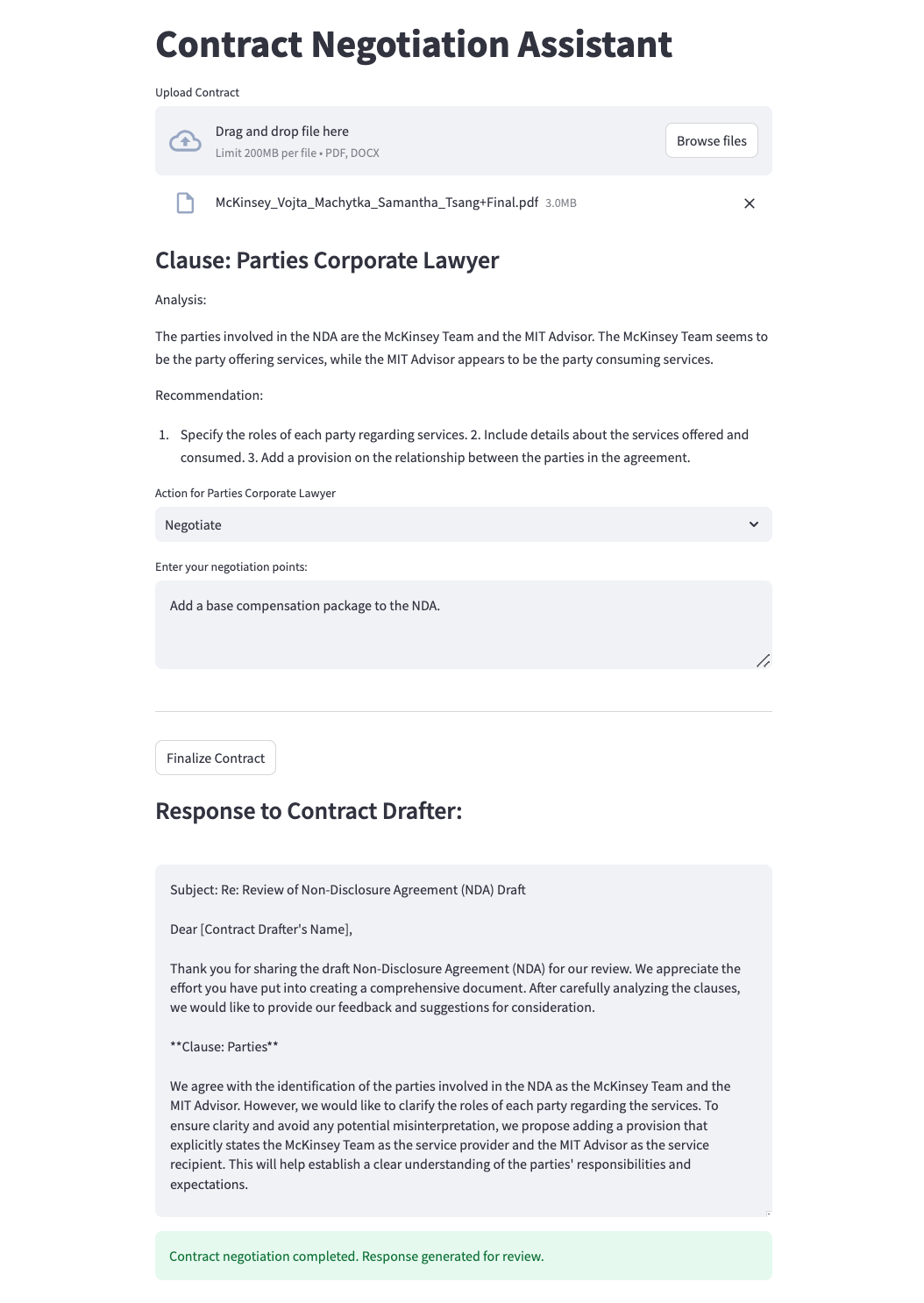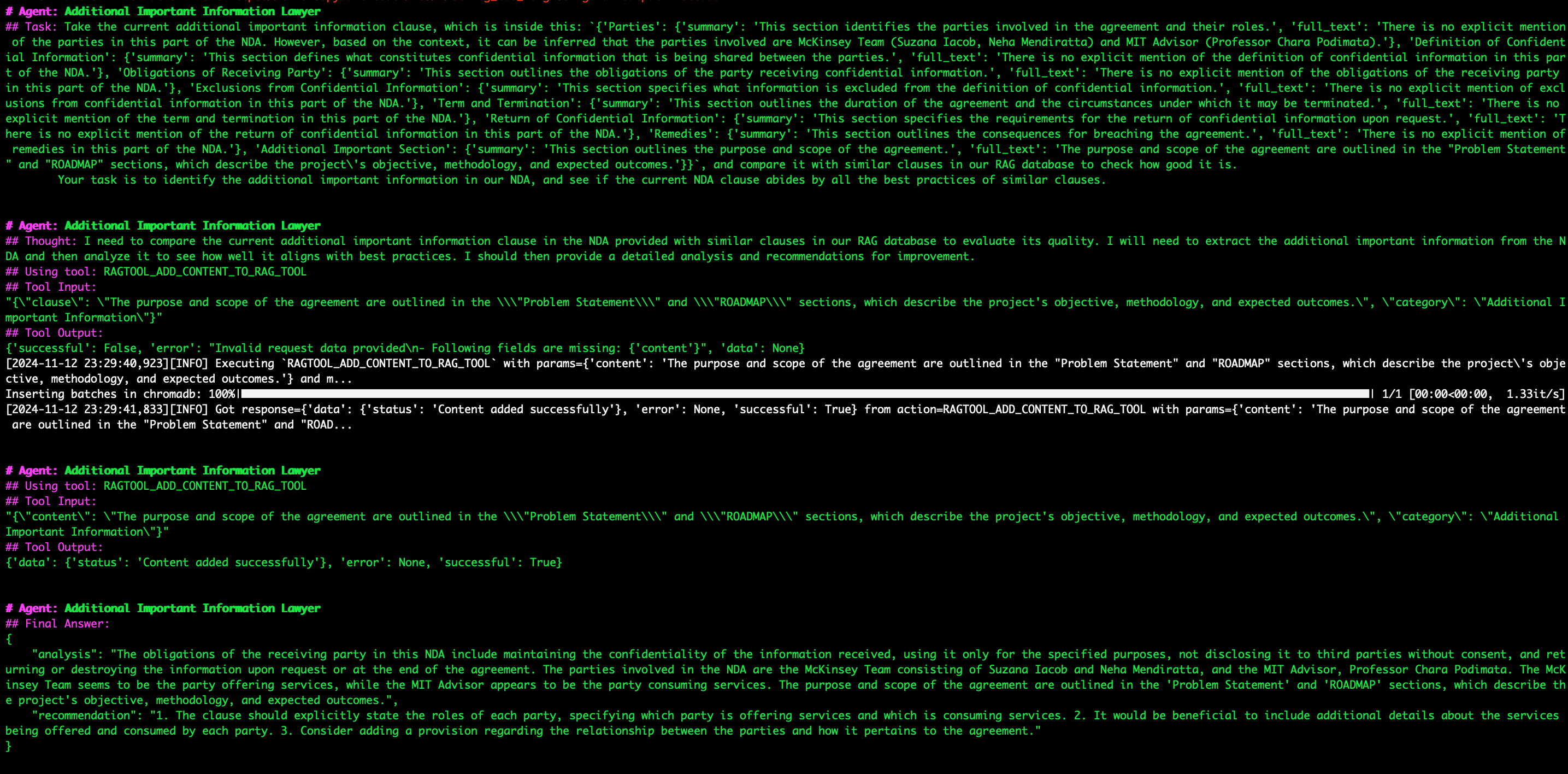An open-source contract negotiation system that leverages various AI technologies to analyze, assist, and streamline the contract negotiation process.
generated with DocToc
Automate the contract review process through the following steps:
-
Document Parsing:
- Uploads a contract document (PDF or DOCX) to the system.
- Uses Upstage's document parser API to convert the contract into plain text.
-
Clause Segmentation:
- Employs Llama 3.1 (running on Together AI) to split the contract text into individual clauses.
- Structures the clauses in JSON format for further processing.
-
AI-Powered Clause Analysis:
- For each clause, triggers an AI agent orchestrated through Crew AI.
- Within each agent, the clause text is passed to the RAGTool function in Composio, which is integrated with Crew AI.
- This RAG system queries a Chroma DB that has been pre-trained on a repository of existing contract clauses.
- Utilizes ChatGPT-4 to generate an analysis of each clause and recommendations for potential improvements, comparing with standard clauses in the Chroma DB.
-
User Interaction:
- Presents the analysis and recommendations to the user through a Streamlit interface.
- Allows the user to choose whether to accept or reject each clause or add points for negotiation.
-
Response Generation:
- Collects all user feedback, including analysis and recommendations for each clause.
- Passes this information back to Llama 3.1 on Together AI.
- Generates a draft response to the original contract drafter, suggesting amendments based on the analysis and user input.
- Automated contract parsing using Upstage's document parser API
- AI-driven clause segmentation using Llama 3.1 on Together AI
- Detailed clause analysis using Crew AI, Composio's RAGTool, and ChatGPT-4
- Comparison with standard clauses stored in Chroma DB
- User-friendly interface for reviewing and providing input on each clause
- Automated generation of response drafts for contract amendments using Llama 3.1
[data-doc-management]
- Upstage: Converts natural language queries into SQL. In this project use Document Parser API to convert contracts to text format Doc
- Chroma DB: Vector database for storing and querying standard contract clauses
- SQLite: Database for storing application data
[ai-model-curation]
- OpenAI GPT-4: Advanced language model for clause analysis and recommendations
- Together AI: Hosting Llama 3.1 for text processing, clause segmentation, and response generation
- AIML API: Curation platform to access AI models and other tasks
- LiteLLM: Curation platform to choose lite LLMs as per objectives Doc: Model Providers
[task-handling]
-
Crew AI: An open-source Python framework designed to support developing and managing multi-agent AI systems
-
Composio: Coonect RAG agents with external tools, Apps, and APIs to perform actions and receive triggers
[deployment-framework]
- Python: Primary programming language
- Flask: Web framework for the backend API
- Streamlit: Frontend user interface
- uv: Fast Python package installer and resolver
- pre-commit: Managing and maintaining pre-commit hooks
- Hatch/Hatchling
.
├── __init__.py
├── app.py # Flask application
├── clause_agents.py # Definitions for AI agents
├── clause_tasks.py # Task definitions for AI agents
├── crew.py # Crew AI orchestration
├── db/ # Database files
│ ├── chroma.sqlite3
│ └── ...
├── models.py # Data models
├── streamlit_app.py # Streamlit frontend
├── tools.py # Utility functions and tools
└── uploads/ # Uploaded contract files
-
Install the
uvpackage manager:pip install uv -
Install dependencies:
uv venv --python=python3.12 source .venv/bin/activate uv pip install -r requirements.txt -v -
Set up environment variables: Create a
.envfile in the project root and add the following:TOGETHER_API_KEY=your_together_api_key UPSTAGE_API_KEY=your_upstage_api_key OPENAI_API_KEY=your_openai_api_key OPENAI_API_BASE=your_openai_api_base OPENAI_MODEL_NAME=your_openai_model_name
-
Start the Flask backend:
uv run python src/components/app.pyThe backend will be available at
http://localhost:5002. -
In a separate terminal, start the Streamlit frontend:
uv run streamlit run src/components/streamlit_app.pyAccess the frontend at
http://localhost:8501in your web browser. -
Upload a contract document through the Streamlit interface.
-
The system will process the document, segment it into clauses, and provide analysis and recommendations for each clause.
-
Review the analysis, accept or reject recommendations, and add negotiation points as needed.
-
Generate a response to the contract drafter based on your inputs.
- Add a package:
uv add <package> - Remove a package:
uv remove <package> - Run a command in the virtual environment:
uv run <command>
-
Install pre-commit hooks:
uv run pre-commit install -
Run pre-commit checks manually:
uv run pre-commit run --all-files
Pre-commit hooks help maintain code quality by running checks for formatting, linting, and other issues before each commit.
*To skip pre-commit hooks
git commit --no-verify -m "your-commit-message"
To modify or add new AI agents, edit the clause_agents.py file. Each agent is defined with a specific role, goal, and set of tools.
The RAG system uses Chroma DB to store and query contract clauses. To update the knowledge base:
- Add new contract documents to the
uploads/directory. - Modify the
tools.pyfile to update the ingestion process if necessary. - Run the ingestion process to update the Chroma DB.
- Fork the repository
- Create your feature branch (
git checkout -b feature/your-amazing-feature) - Commit your changes (
git commit -m 'Add your-amazing-feature') - Push to the branch (
git push origin feature/your-amazing-feature) - Open a pull request
Common issues and solutions:
- API key errors: Ensure all API keys in the
.envfile are correct and up to date. (See.env.init) - Database connection issues: Check if the Chroma DB is properly initialized and accessible.
- Memory errors: If processing large contracts, you may need to increase the available memory for the Python process.
- Issues related to the AI agents or RAG system: Check the
output.logfile for detailed error messages and stack traces.


